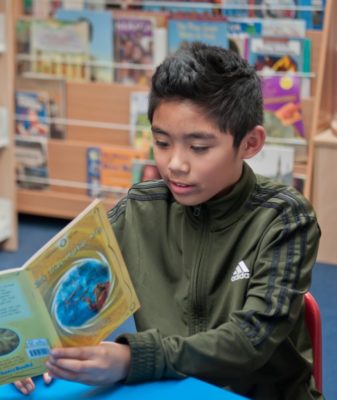 Read books that are at the appropriate level of difficulty. If you are not certain which books are suitable, download the assessment materials on the website and assess the reader.
Read books that are at the appropriate level of difficulty. If you are not certain which books are suitable, download the assessment materials on the website and assess the reader.- Make sure that the reader knows the target phoneme in the book before reading it. If he or she does not, do the activities in the corresponding chapter of the workbook. These activities should include: blending (pushing sounds together), segmenting (separating sounds), reading and sorting words.
- Encourage the reader to read new words by blending.
- Read with the child in short bursts.
- If the reader is getting tired, read alternate pages or paragraphs. Be patient – give the child time to work the word out by sounding it out.
- If a child has ommitted sounds or inserted sounds into a word, point out where this has happened so that graphemes (letters) and phonemes (sounds) match. Give the child the opportunity to self-correct.
- If the child does not know the sound of a grapheme, tell him/her what it is, but let the child blend it into the word himself/herself.
- High-frequency words are common words, some of which have complex spellings, e.g. words like ‘said’. At this stage the reader nay have difficulty reading them. To help with these words, point to the graphemes and say the sounds and, if the child is not ready to read it, or has difficulty blending the sounds together, then say the word for him/her. In time the reader will being to recognize them.
- Read each sentence for the child after he/she has decoded it in order to help comprehension.
- Discuss new vocabulary.
- Discuss story, characters, illustrations and the likes and dislikes of the reader.
- If possible, get the reader to do some comprehension activities from the corresponding chapter in the workbooks.
- Use lots of praise and encouragement.
Glossary
Blending
Saying the sounds in a word and pushing them together into a recognizable word
Segmenting
Separating sounds in a word
Decoding
Reading – working out the letter sounds and pushing them together (blending them together) to say the word
Phoneme
The sound the letter or group of letters (grapheme) represents
Grapheme
A letter or group of letters that represent a sound (phoneme):
- <c> in ‘cat’ is a one-letter grapheme that represents the sound or phoneme ‘k’
- <ai> in ‘rain’ is a two-letter grapheme that represents the sound or phoneme ‘ae’
- <igh>in ‘night’ is a three-letter grapheme that represents the sound or phoneme ‘ie’
- <ough> in ‘though’ is a four-letter grapheme that represents the sound of phoneme ‘oe’

